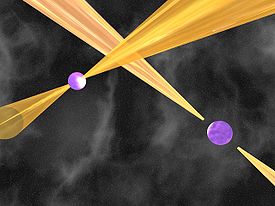PSR J0737-3039
|
Pulsar PSR J0737-3039 |
||||
|---|---|---|---|---|

|
||||
| artist's impression | ||||
|
Observation dates equinox : J2000.0 , epoch : J2000.0 |
||||
| Constellation | Aft deck of the ship | |||
| Right ascension | 07 h 37 m 51.2 s | |||
| declination | -30 ° 39 ′ 40.7 ″ | |||
| Astrometry | ||||
| distance | 1,600 - 2,000 ly 600 pc |
|||
| Physical Properties | ||||
| Rotation period | A: 23 ms B: 2.8 s |
|||
| Dimensions | A: 1.337 M ☉ B: 1.25 M ☉ |
|||
|
Other names and catalog entries |
||||
|
||||
| Aladin previewer | ||||
| annotation | ||||
| Double system with a cycle time of 2.4 hours and a distance of 850,000 km to each other. | ||||
PSR J0737-3039 is the first known double pulsar system . It was discovered in 2003 by a team (led by Marta Burgay from the University of Bologna, Italy) using an Australian 64-meter radio telescope.
The object is comparable to PSR 1913 + 16 , which was discovered by Taylor and Hulse in 1974 and for whose investigation the two received the 1993 Nobel Prize in Physics . Objects of this kind enable the precise testing of Einstein's general theory of relativity , because relativistic effects cause a change in the orbit (and thus a change in the radio pulses over time) of the pulsars (see also apse rotation ). Most of such known binary systems consist of a pulsar and a neutron star . J0737-3039 is the first case where both components are pulsars.
The rotation time of J0737-3039 (2.4 hours) is the smallest currently known for such an object (one third of the rotation time of the Taylor-Hulse object), which enables even more precise measurements. However, the pulses from pulsar B can only be received for about 20 minutes per cycle. In 2005 it was confirmed that the measurements show an excellent agreement between the predictions of general relativity and observation. In particular, the forecasts for energy loss due to gravitational waves agree with the theory.
As a result of the energy loss due to the gravitational waves, the common orbit shrinks by 7 mm per day, causing the two components to collide in about 85 million years.